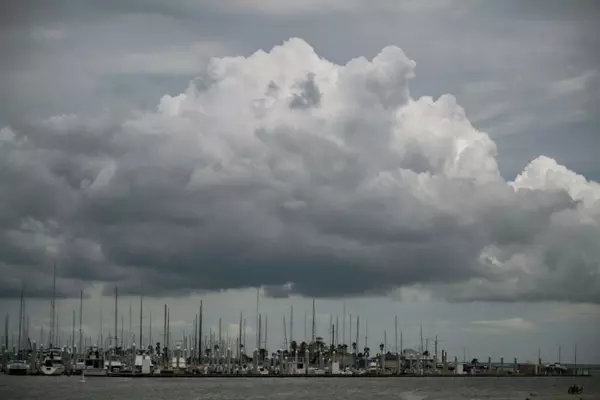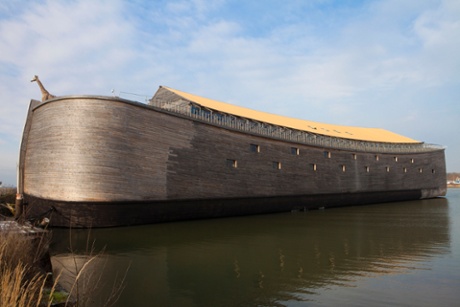
Ark of Noah, Dordrecht, the Netherlands
Don’t bother watching it, but Evan Almighty is a trashy comedy flick in which some modern guy builds an ark just like Noah. Anyway, a much better movie would have been one about the actual modern guy who built an ark just like Noah in the Netherlands – which is actually a country prone to flooding. Johan Huibers was inspired to build an ark in 1992, when he had a dream about a great flood. In 2007, he opened a smaller model (still, 70m long is not to be scoffed at), before setting to work on one made to Noah’s (reputed) original dimensions: 30m wide, 23m high and 135m long. This opened to the public in 2012 and contains exhibitions about Noah, as well as being home to a range of animals, including rabbits, horses and kangaroos.
• Adults €12.50, kids €7.50, arcofnoah.org
Dr Evermor’s Forevertron, Sumpter, Wisconsin, US
Tom Every, AKA Dr Evermor, is a former industrial wrecker from Wisconsin who has been building fantastical creations out of scrap metal since 1983. According to Every, his alter ego Dr Evermor is a Victorian professor from Eggington in Bedfordshire, England, who was inspired to build a spacecraft after experiencing an epic lightning storm. This is where the Forevertron comes in: the 300-tonne sculpture features a glass capsule for Dr Evermor to perch in when he eventually transports himself back to space. As well as the Forevertron, there are other contraptions to explore: the Graviton and the Celestial Listening Ears, for example, with remnants from industrial-age factories and power plants among the works of art. The decontamination chamber from the Apollo space mission is among the most notable pieces of scrap to find a new life thanks to Dr Evermor.
• Admission free, but booking a visit on +1 608 219 7830 is recommneded, worldofdrevermor.com
Ai Pioppi Playground, Montello, Italy
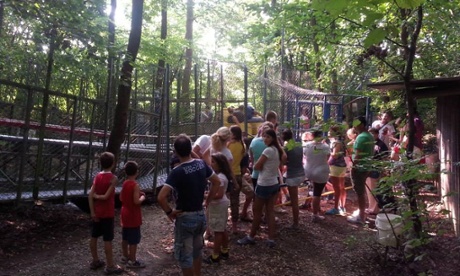
As DIY theme parks go, Ai Pioppi’s is an impressive – albeit slightly nerve-racking – proposition. The homemade amusement park is in a forested area behind a family restaurant in northern Italy. Owner Bruno opened the restaurant in 1969, before spending the next four decades welding together the most ambitious after-dinner entertainment project you could imagine. Ranging from slides to kinetic rollercoasters, the playground is free to all restaurant customers (though it’s probably worth digesting a little of that food before you hop on a ride).
• aipioppi.com
Josep Pujiula’s Labyrinth, Argelaguer, Spain
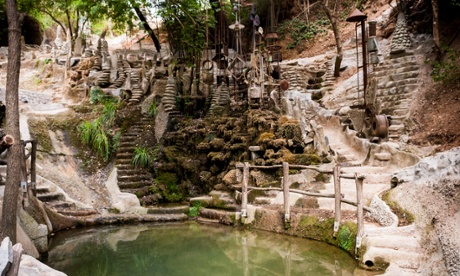
Eerily beautiful (though maybe a little spooky at times), Josep Pujiula has created a vast handmade maze beside the Fluvià River in Argelaguer, Catalonia. The textile worker began making it in 1980, before having to demolish it in 2002 to make way for a motorway. Unperturbed, Pujiula began rebuilding his masterpiece on a spot nearby, and visitors can now wander through tubed walkways formed from a woven lattice made of concrete, recycled materials, stone and wood. The battle with the authorities over its existence continued up until October 2014, when the local government finally agreed to award it local heritage status. Now it’s among the finalists of the International Award for Public Art 2015.
Coral Castle, Homestead, Florida, US
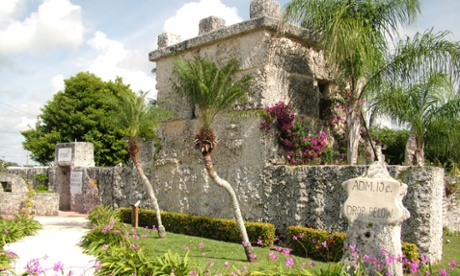
An early 20th-century folly, Coral Castle was built in 1920 by Edward Leedskalnin, who Wikipedia concisely sums up as a “Latvian-American eccentric”. Not the luckiest man, Leedskalnin left for the US after being jilted by his 16-year-old fiancee. He contracted TB on his arrival but managed to recover and begin constructing a castle from blocks of limestone coral. He spent 28 years building it until his death in 1951, declaring his “sweet sixteen” to be the inspiration. In that time he intricately carved 1,100 tonnes of stone to create furniture, walls and a castle tower. One of the most impressive feats of engineering was an 8ft, 8-tonne, revolving stone gate balanced on an axis so perfectly that it could be moved with one finger. The mysterious project inspired Billy Idol to record his song, Sweet Sixteen, as a tribute to the castle.
• Adults $15, kids $7, coralcastle.com
The Crazy House, Dalat, Vietnam
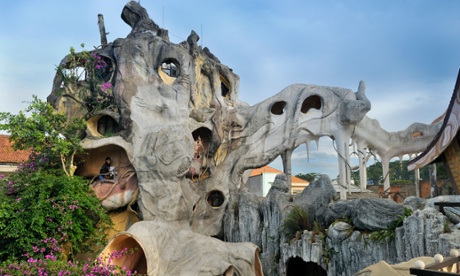
Resembling a cheese grater that’s melted, the Crazy House is a fantastic construction that its website describes as “Gaudi-meets-Sesame Street”. The house was built by architect Dang Viet Nga, who didn’t follow traditional plans when building it, instead opting to craft it from paintings. The five-floor building has 10 guest rooms themed on different animals and the corridors resemble tunnels. Luckily for Nga, who racked up debts in pursuit of her dream home, the house has become a popular tourist attraction since she opened it to visitors in 1990.
• Rooms from US$25 a night, crazyhouse.vn
Cement Menagerie, Branxton, Northumberland, UK
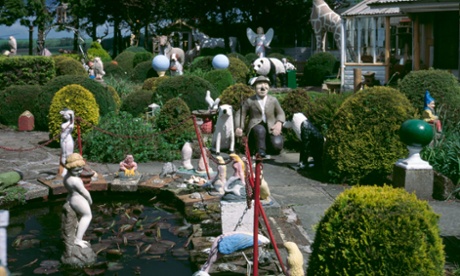
A heartwarming story lies behind this extraordinary garden filled with colourful handmade sculptures of animals (and a few humans). The garden was built by John Fairnington, a retired master joiner – who was actually 80 when he started work on it – and his wife, Mary, for the entertainment of their disabled son who they cared for at home. Built in the 1960s, there are around 300 statues in the garden, including zebras, rhinos and crocodiles, all built from chicken wire and concrete. Although the family who created it have died, the garden is now looked after by their relatives.
• The Fountain House is open daily from Easter to October, free
Wat Lan Khaud, Sisaket Province, Thailand
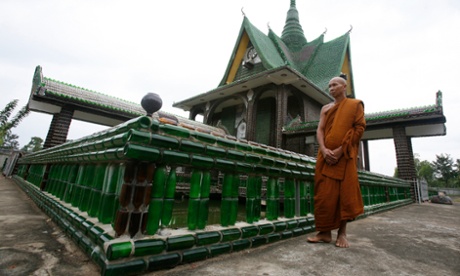
It took 1.5 million beer bottles to create this brown and emerald shrine to the fizzy stuff close to the Thai/Cambodia border. Built by a group of monks (who, for the record, played no part in emptying the bottles), the temple came about after they began asking locals to bring their empty Chang and Heinekens to them. The monks built a complex out of the bottles – using the tops to create mosaics inside the temple – and are still adding to it. As Abbot San Kataboonyo puts it: “The more bottles we get, the more buildings we make.”
Bishop Castle, Colorado, US
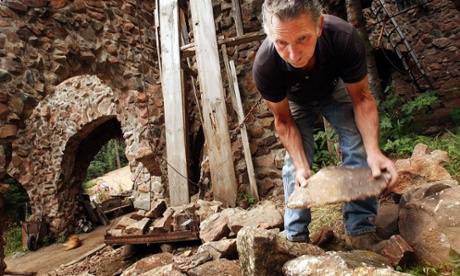
Jim Bishop has certainly proved wrong the English teacher who shouted at him: “You’ll never amount to anything!” The high-school dropout persuaded his parents to buy him a small plot of land in Colorado’s San Isabel national forest. Ten years on, married and then 25 years old, Bishop began building a one-room stone cottage. That was 1969. Now the land is the site of an epic homemade castle complete with turrets and a fire-breathing dragon mounted on one of the chimneys. The stone-and-iron masterpiece, which reaches 160ft, has remained a work in progress to this day.
• Admission free, bishopcastle.org
Freedom Cove, Cypress Bay, British Columbia, Canada
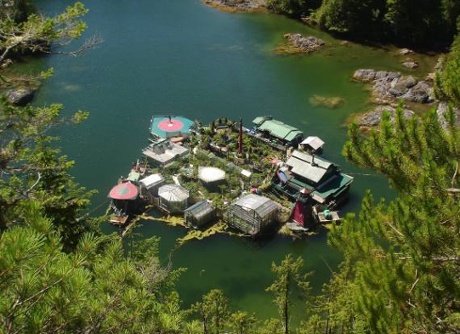
A secret, floating wonderland, Freedom Cove is an art installation that is a showcase for alternative sustainable living. Also known as Wayne and Catherine’s Gardens, after the artist couple who live there and created it, the collection of houseboats came into existence in 1992. The site – almost an island in its own right – consists of 12 floating platforms, with five greenhouses, a studio and gallery and its residents live off the vegetables they grow there, as well as the fish caught in the coastal inlet. Visitors can reach Freedom Cover, in Cypress Bay, by kayak or on a charter boat tour.
